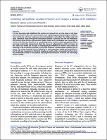| dc.contributor.author | O'Driscoll, Lorraine | |
| dc.contributor.author | Catalano, Mariadelva | |
| dc.date.accessioned | 2020-02-12T16:35:21Z | |
| dc.date.available | 2020-02-12T16:35:21Z | |
| dc.date.issued | 2019 | |
| dc.date.submitted | 2019 | en |
| dc.identifier.citation | Catalano, M. & O'Driscoll, L., Inhibiting extracellular vesicles formation and release: a review of EV inhibitors, Journal of Extracellular Vesicles, 9, 1, 2019, 1703244 - 1703258 | en |
| dc.identifier.other | Y | |
| dc.identifier.uri | https://www.tandfonline.com/doi/full/10.1080/20013078.2019.1703244 | |
| dc.identifier.uri | http://hdl.handle.net/2262/91505 | |
| dc.description.abstract | It is now becoming well established that vesicles are released from a broad range of cell types and are involved in cell-to-cell communication, both in physiological and pathological conditions. Once outside the cell, these vesicles are termed extracellular vesicles (EVs). The cellular origin (cell type), subcellular origin (through the endosomal pathway or pinched from the cell membrane) and content (what proteins, glycoproteins, lipids, nucleic acids, metabolites) are transported by the EVs, and their size, all seem to be contributing factors to their overall heterogeneity. Efforts are being invested into attempting to block the release of subpopulations of EVs or, indeed, all EVs. Some such studies are focussed on investigating EV inhibitors as research tools; others are interested in the longerterm potential of using such inhibitors in pathological conditions such as cancer. This review, intended to be of relevance to both researchers already well established in the EV field and newcomers to this field, provides an outline of the compounds that have been most extensively studied for this purpose, their proposed mechanisms of actions and the findings of these studies. | en |
| dc.format.extent | 1703244 | en |
| dc.format.extent | 1703258 | en |
| dc.language.iso | en | en |
| dc.relation.ispartofseries | 9; | |
| dc.relation.ispartofseries | 1; | |
| dc.relation.ispartofseries | Journal of Extracellular Vesicles; | |
| dc.rights | Y | en |
| dc.subject | Extracellular vesicles | en |
| dc.subject | Exosomes | en |
| dc.subject | Microvesicles | en |
| dc.subject | Inhibitors | en |
| dc.subject | Calpeptin | en |
| dc.subject | Y27632 | en |
| dc.subject | Pantethine | en |
| dc.subject | Imipramine | en |
| dc.subject | GW4869 | en |
| dc.subject | Manumycin A | en |
| dc.title | Inhibiting extracellular vesicles formation and release: a review of EV inhibitors. | en |
| dc.type | Journal Article | en |
| dc.type.supercollection | scholarly_publications | en |
| dc.type.supercollection | refereed_publications | en |
| dc.identifier.peoplefinderurl | http://people.tcd.ie/lodrisc | |
| dc.identifier.rssinternalid | 211968 | |
| dc.identifier.doi | 10.1080/20013078.2019.1703244 | |
| dc.rights.ecaccessrights | openAccess | |
| dc.subject.TCDTheme | Cancer | en |
| dc.subject.TCDTag | BREAST CANCER | en |
| dc.subject.TCDTag | CANCER | en |
| dc.subject.TCDTag | Extracellular Vesicles | en |
| dc.subject.TCDTag | exosomes | en |
| dc.identifier.orcid_id | 0000-0002-9860-8262 | |
| dc.subject.darat_thematic | Health | en |
| dc.status.accessible | N | en |
| dc.contributor.sponsor | Marie Curie | en |
| dc.contributor.sponsorGrantNumber | TRAIN-EV (722148) | en |
| dc.contributor.sponsor | Irish Research Council (IRC) | en |
| dc.contributor.sponsorGrantNumber | IRCLA/2019/49 | en |




